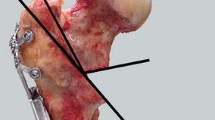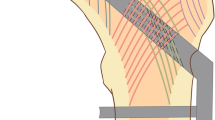Abstract
The design rationale of extramedullary fixation for femur fracture has remained a matter of debate in the orthopaedic community. The present work provides a comparative preclinical assessment between two standard fracture fixation techniques: dynamic hip screw (DHS) and proximal femoral locking plate (PFLP), by employing finite element (FE)-based in silico models. The study attempts to evaluate and compare the two implants on following biomechanical behaviours: (1) stress variation on the femur and implant, (2) axial displacement of the fixated femur constructs, (3) postoperative stress shielding and longer term external remodelling of the host bone. We hypothesised that, of the two implants, PFLP has better biomechanical characteristics when used for subtrochanteric femoral fracture (SFF) fixation considering long-term adaptation. A comminuted fracture, simulated as two-part fracture gap of 20 mm, was created in the subtrochanteric region of a femur CAD model. Non-uniform physiological load cases were considered. External bone adaptation was modelled mathematically using stress analysis coupled with a growth model, in which strain energy density (SED) acted as feedback control variable. The computational results predicted lower stress shielding (by ~ 6%) and relatively less cortical thinning beneath the plate for PFLP as compared to DHS. DHS-fixated femur, on the other hand, predicted superior postoperative rigidity.

FE-based comparative assessment between two extramedullary femur fixation devices—dynamic hip screw (DHS) and proximal femoral locking plate (PFLP).











Similar content being viewed by others
References
Koval KJ, Zuckerman JD, Joseph D (2006) Handbook of fractures. Lippincott Williams & Wilkins
Medda S, RARHP (2020) Subtrochanteric femur fractures - StatPearls - NCBI Bookshelf
Jonnes C, Shishir SM, Najimudeen S (2016) Type II intertrochanteric fractures: proximal femoral nailing (PFN) versus dynamic hip screw (DHS). Arch Bone Jt Surg 4:23–28. https://doi.org/10.22038/abjs.2016.5268
Butler M, Forte M, Kane RL et al (2009) Treatment of common hip fractures. Evid Rep Technol Assess (Full Rep) 184:1–85
Kulkarni GS, Limaye R, Kulkarni M, Kulkarni S (2006) Intertrochanteric fractures. Indian J Orthop 40:16–23
Swift C, Chesser T, Field A, et al (2010) The management of hip fracture in adults - NICE guideline 27
Morris A, Zuckerman J (2002) National consensus conference on improving the continuum of care of patients with hip fracture. J Bone Joint Surg 84:670–674. https://doi.org/10.2106/00004623-200204000-00027
Madsen JE, Næss L, Aune AK, Alho A, Ekeland A, Strømsøe K (1998) Dynamic hip screw with trochanteric stabilizing plate in the treatment of unstable proximal femoral fractures: a comparative study with the gamma nail and compression hip screw. J Orthop Trauma 12:241–248. https://doi.org/10.1097/00005131-199805000-00005
Setiobudi T, Hong Ng Y, Tat Lim C, et al (2011) Clinical outcome following treatment of stable and unstable intertrochanteric fractures with dynamic hip screw
Zhong B, Zhang Y, Zhang C, Luo CF (2014) A comparison of proximal femoral locking compression plates with dynamic hip screws in extracapsular femoral fractures. Orthop Traumatol Surg Res 100:663–668. https://doi.org/10.1016/j.otsr.2014.06.012
Glassner PJ, Tejwani NC (2011) Failure of proximal femoral locking compression plate: a case series. J Orthop Trauma 25:76–83. https://doi.org/10.1097/BOT.0b013e3181e31ccc
Streubel PN, Moustoukas MJ, Obremskey WT (2013) Mechanical failure after locking plate fixation of unstable intertrochanteric femur fractures. J Orthop Trauma 27:22–28. https://doi.org/10.1097/BOT.0b013e318251930d
Sommer C, Gautier E, Müller M, Helfet DL, Wagner M (2003) First clinical results of the locking compression plate (LCP). Injury 34:43–54. https://doi.org/10.1016/j.injury.2003.09.024
Ferguson SJ, Wyss UP, Pichora DR (1996) Finite element stress analysis of a hybrid fracture fixation plate. In: Medical Engineering and Physics. Butterworth-Heinemann Ltd, pp. 241–250
Tonino AJ, Davidson CL, Klopper PJ, Linclau LA (1976) Protection from stress in bone and its effects. Experiments with stainless steel and plastic plates in dogs. J Bone Jt Surg - Ser B 58:107–113. https://doi.org/10.1302/0301-620x.58b1.1270486
Uhthoff HK, Dubuc FL (1971) Bone structure changes in the dog under rigid internal fixation. Clin Orthop Relat Res 81:165–170. https://doi.org/10.1097/00003086-197111000-00026
Cowin SC, Hegedus DH (1976) Bone remodeling I: theory of adaptive elasticity. J Elast 6:313–326. https://doi.org/10.1007/BF00041724
Huiskes R, Weinans H, Grootenboer HJ, Dalstra M, Fudala B, Slooff TJ (1987) Adaptive bone-remodeling theory applied to prosthetic-design analysis. J Biomech 20:1135–1150. https://doi.org/10.1016/0021-9290(87)90030-3
Weinans H, Huiskes R, Grootenboer HJ (1992) The behavior of adaptive bone-remodeling simulation models. J Biomech 25:1425–1441. https://doi.org/10.1016/0021-9290(92)90056-7
Carter DR, Van Der Meulen MCH, Beaupré GS (1996) Mechanical factors in bone growth and development. In: Bone. Elsevier Inc., pp. S5–S10
van Der Meulen MCH, Beaupré GS, Carter DR (1993) Mechanobiologic influences in long bone cross-sectional growth. Bone 14:635–642. https://doi.org/10.1016/8756-3282(93)90085-O
Doblaré M, García JM (2002) Anisotropic bone remodelling model based on a continuum damage-repair theory. J Biomech 35:1–17. https://doi.org/10.1016/S0021-9290(01)00178-6
Prendergast PJ, Taylor D (1994) Prediction of bone adaptation using damage accumulation. J Biomech 27:1067–1076. https://doi.org/10.1016/0021-9290(94)90223-2
Latifi MH, Ganthel K, Rukmanikanthan S, Mansor A, Kamarul T, Bilgen M (2012) Prospects of implant with locking plate in fixation of subtrochanteric fracture: experimental demonstration of its potential benefits on synthetic femur model with supportive hierarchical nonlinear hyperelastic finite element analysis. Biomed Eng Online 11:1. https://doi.org/10.1186/1475-925X-11-23
Wang J, Ma JX, Lu B, Bai HH, Wang Y, Ma XL (2020) Comparative finite element analysis of three implants fixing stable and unstable subtrochanteric femoral fractures: proximal femoral nail antirotation (PFNA), proximal femoral locking plate (PFLP), and reverse less invasive stabilization system (LISS). Orthop Traumatol Surg Res 106:95–101. https://doi.org/10.1016/j.otsr.2019.04.027
Sowmianarayanan S, Chandrasekaran A, Kumar RK (2008) Finite element analysis of a subtrochanteric fractured femur with dynamic hip screw, dynamic condylar screw, and proximal femur nail implants--a comparative study. Proc Inst Mech Eng H 222:117–127. https://doi.org/10.1243/09544119JEIM156
Floyd JCP, O’Toole RV, Stall A et al (2009) Biomechanical comparison of proximal locking plates and blade plates for the treatment of comminuted subtrochanteric femoral fractures. J Orthop Trauma 23:628–633. https://doi.org/10.1097/BOT.0b013e3181b04835
Viceconti M, Bellingeri L, Cristofolini L, Toni A (1997) A comparative study on different methods of automatic mesh generation of human femurs. Med Eng Phys 20(1):1–10
Chanda S, Dickinson A, Gupta S, Browne M (2015) Full-field in vitro measurements and in silico predictions of strain shielding in the implanted femur after total hip arthroplasty. Proc Inst Mech Eng Part H J Eng Med 229:549–559. https://doi.org/10.1177/0954411915591617
ISO - ISO 7206-4:2010 - Implants for surgery — partial and total hip joint prostheses — part 4: determination of endurance properties and performance of stemmed femoral components. https://www.iso.org/standard/42769.html. Accessed 14 Apr 2020
Bergmann G, Deuretzbacher G, Heller M, et al (2001) Hip contact forces and gait patterns from routine activities. In: Journal of Biomechanics. J Biomech, pp. 859–871
Heller MO, Bergmann G, Deuretzbacher G, Dürselen L, Pohl M, Claes L, Haas NP, Duda GN (2001) Musculo-skeletal loading conditions at the hip during walking and stair climbing. J Biomech 34:883–893. https://doi.org/10.1016/S0021-9290(01)00039-2
Biomechanical products catalog Sawbones: Test materials and composite bones. https: https://www.sawbones.com/media/assets/product/documents/biomechanical_catalog2020.pdf Accessed 7 Dec 2020
Eberle S, Augat P (2007) Preventing contact convergence problems in bone- implant contact models
Devika D, Gupta NS (2012) Finite element analysis and validation of the critical parameters influencing the mechanical behaviour of tibia bone with patient-specific implant for proximal end fracture. Trends in Biomaterials & Artificial Organs 26(1):10–15
Chanda S, Gupta S, Pratihar DK (2016) A combined neural network and genetic algorithm based approach for optimally designed femoral implant having improved primary stability. Appl Soft Comput 38:296–307
Hoffman O (1967) The brittle strength of orthotropic materials. J Compos Mater 1:200–206. https://doi.org/10.1177/002199836700100210
Reilly DT, Burstein AH (1975) The elastic and ultimate properties of compact bone tissue. J Biomech 8:393–405. https://doi.org/10.1016/0021-9290(75)90075-5
Chennimalai Kumar N, Dantzig JA, Jasiuk IM (2012) Modeling of cortical bone adaptation in a rat ulna: effect of frequency. Bone 50:792–797. https://doi.org/10.1016/j.bone.2011.12.008
Chennimalai Kumar N, Dantzig JA, Jasiuk IM, et al (2010) Numerical modeling of long bone adaptation due to mechanical loading: correlation with experiments. In: Annals of Biomedical Engineering. Ann Biomed Eng, pp. 594–604
Terjesen T, Nordby A, Arnulf V (1985) Bone atrophy after plate fixation: computed tomography of femoral shaft fractures. Acta Orthop 56:416–418. https://doi.org/10.3109/17453678508994361
Rubin CT, Lanyon LE (1985) Regulation of bone mass by mechanical strain magnitude. Calcif Tissue Int 37:411–417. https://doi.org/10.1007/BF02553711
Sugiyama T, Meakin LB, Browne WJ, Galea GL, Price JS, Lanyon LE (2012) Bones’ adaptive response to mechanical loading is essentially linear between the low strains associated with disuse and the high strains associated with the lamellar/woven bone transition. J Bone Miner Res 27:1784–1793. https://doi.org/10.1002/jbmr.1599
Avval PT, Samiezadeh S, Bougherara H (2016) Long-term response of femoral density to hip implant and bone fracture plate: computational study using a mechano-biochemical model. Med Eng Phys 38:171–180. https://doi.org/10.1016/j.medengphy.2015.11.013
Wang J, Ma X, Ma J, Xing D, Yang Y, Zhu SW, Ma BY, Chen Y, Feng R, Jia HB, Yu JT (2014) Biomechanical analysis of four types of internal fixation in subtrochanteric fracture models. Orthop Surg 6:128–136. https://doi.org/10.1111/os.12109
Forward DP, Doro CJ, O’Toole RV et al (2012) A biomechanical comparison of a locking plate, a nail, and a 95° angled blade plate for fixation of subtrochanteric femoral fractures. J Orthop Trauma 26:334–340. https://doi.org/10.1097/BOT.0b013e3182254ea3
Wieser K, Babst R (2010) Fixation failure of the LCP proximal femoral plate 4.5/5.0 in patients with missing posteromedial support in unstable per-, inter-, and subtrochanteric fractures of the proximal femur. Arch Orthop Trauma Surg 130:1281–1287. https://doi.org/10.1007/s00402-010-1074-7
Terjesen T, Nordby A, Arnulf V (1986) The extent of stress-protection after plate osteosynthesis in the human tibia. Clin Orthop Relat Res 108–12
Blanchard R, Dejaco A, Bongaers E, Hellmich C (2013) Intravoxel bone micromechanics for microCT-based finite element simulations. J Biomech 46(15):2710–2721. https://doi.org/10.1016/j.jbiomech.2013.06.036
Acknowledgements
The authors would like to acknowledge the computational facilities available at the Biomechanics Laboratory, Biosciences and Bioengineering, Indian Institute of Technology Guwahati, India, which has helped to carry out this research study. The authors would also like to acknowledge Dr. Bhaskar Borgohain, Orthopaedic Surgeon, North Eastern Indira Gandhi Regional Institute of Health & Medical Sciences, Shillong, India, for his invaluable inputs.
Funding
The study has been partially supported by SERB, India (Grant no. SRG/2019/000235).
Author information
Authors and Affiliations
Corresponding author
Ethics declarations
Conflict of interest
The authors declare that they have no conflicts of interest.
Additional information
Publisher’s note
Springer Nature remains neutral with regard to jurisdictional claims in published maps and institutional affiliations.
Rights and permissions
About this article
Cite this article
Nag, P., Chanda, S. Biomechanical design prognosis of two extramedullary fixation devices for subtrochanteric femur fracture: a finite element study. Med Biol Eng Comput 59, 271–285 (2021). https://doi.org/10.1007/s11517-020-02306-6
Received:
Accepted:
Published:
Issue Date:
DOI: https://doi.org/10.1007/s11517-020-02306-6




